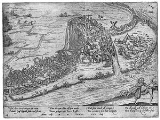
Battle of Jemmingen
Encyclopedia
After the Battle of Heiligerlee
Louis of Nassau
failed to capture the city Groningen. Louis was driven away by Fernando Álvarez de Toledo, Duke of Alba and defeated at the Battle of Jemmingen (also known as Battle of Jemgum, at Jemgum
in East Frisia
) on 21 July 1568.
s), 3,000 cavalry, and some cannon. Louis of Nassau opposed them with 10,000 infantry (2 groups), some cavalry, and 16 cannons.
. In 1577 the statue was destroyed by an angry crowd.
Battle of Heiligerlee
The Battle of Heiligerlee was fought between Dutch rebels and the Spanish army of Friesland. This was the first Dutch victory during the Eighty Years' War....
Louis of Nassau
Louis of Nassau
Louis of Nassau was the third son of William, Count of Nassau and Juliana of Stolberg, and the younger brother of Prince William of Orange Nassau....
failed to capture the city Groningen. Louis was driven away by Fernando Álvarez de Toledo, Duke of Alba and defeated at the Battle of Jemmingen (also known as Battle of Jemgum, at Jemgum
Jemgum
Jemgum is a municipality in the Leer district, in the northwest of Lower Saxony, Germany. The area is known as Rheiderland or Reiderland . The Rheiderland is located in East Friesland....
in East Frisia
East Frisia
East Frisia or Eastern Friesland is a coastal region in the northwest of the German federal state of Lower Saxony....
) on 21 July 1568.
Forces
The Spanish army consisted of 12,000 infantry (4 tercioTercio
The tercio was a Renaissance era military formation made up of a mixed infantry formation of about 3,000 pikemen, swordsmen and arquebusiers or musketeers in a mutually supportive formation. It was also sometimes referred to as the Spanish Square...
s), 3,000 cavalry, and some cannon. Louis of Nassau opposed them with 10,000 infantry (2 groups), some cavalry, and 16 cannons.
Battle
After three hours of skirmishes, Louis' army left its trenches and advanced. Pounded by effective musket fire and intimidated by the Spanish cavalry, the advance turned into a general retreat towards the river Ems.Aftermath
On May 19, 1571 a statue of the Duke, cast from one of the captured bronze cannon, was placed in Antwerp citadelCitadel
A citadel is a fortress for protecting a town, sometimes incorporating a castle. The term derives from the same Latin root as the word "city", civis, meaning citizen....
. In 1577 the statue was destroyed by an angry crowd.

